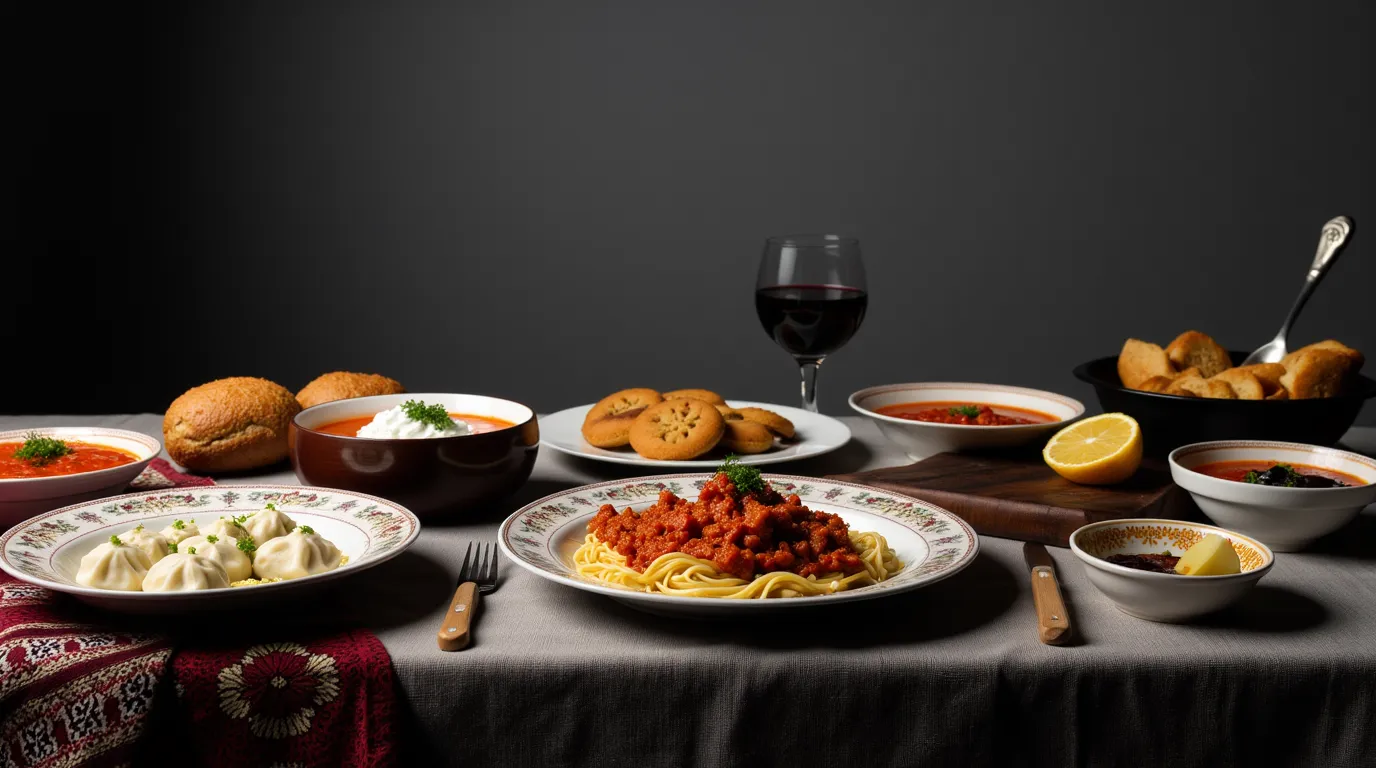Table of Contents
Table of Contents
Introduction
Russian cuisine stands as a rich tapestry of flavors, traditions, and cultural heritage that has evolved over centuries to become one of the most fascinating gastronomies in the world. Steeped in history, influenced by geography, and shaped by the ingenuity of its people, Russian cuisine offers an incredible range of dishes that reflect the country’s diversity and creative spirit. From hearty soups that warm you in the cold winter months to delicate pastries that showcase the refined techniques of Russian bakers, there is something appealing for every food enthusiast. In recent years, the growing interest in global cuisines has directed many food explorers to the wonders of Russian cooking, unveiling the country’s culinary treasures far beyond the well-known stereotypes of vodka and caviar.
In this article, we will delve into the multifaceted world of Russian cuisine—its culinary context, its historical evolution, and the key ingredients that have long defined traditional Russian dishes. We will explore the flagship meals that every visitor or curious cook should try, highlighting how these traditional dishes have shaped Russia’s cultural identity. Furthermore, we will discuss the distinctive characteristics that make Russian cuisine unique, as well as table rituals, customs, and the modern trends that keep this culinary tradition in constant evolution. By the end of this thorough exploration, you will have gained deeper insight into the roots of Russian cuisine, discovered new reasons to savor its delights, and perhaps be inspired to re-create some of these iconic recipes in your own kitchen.
Culinary Context and History
The story of Russian cuisine stretches back to the earliest Slavic tribes who inhabited the vast lands that would eventually form the Russian state. The harsh climate and sweeping geography shaped how people gathered, hunted, and preserved food. In early times, limited access to certain grains and produce led to an emphasis on hearty staples, such as rye bread, porridge-like dishes made from wheat or buckwheat, and preserved meats or fish. As the Russian Empire expanded over centuries, new culinary influences emerged from the trade routes, migrations, and cultural exchanges with neighboring regions.
Historical, Cultural, and Geographical Influences
Russia’s enormous territory, stretching from Eastern Europe to the edges of Asia, encompasses diverse landscapes that offer varied agricultural products and resources. The northern regions, with their colder climates, rely heavily on root vegetables, pickling techniques, and robust soups to survive harsh winters. Southern areas, blessed with a more temperate climate, grow an abundance of fruits and vegetables, influencing their local cuisines with lighter dishes and fresh produce. Central Russia is historically known for its vast grain fields, supporting the production of bread, pastry dough, and cereals, which hold a prominent place in many Russian meals.
Culturally, the adoption of Christianity in the 10th century brought new practices, including Orthodox fasting rituals. These rituals imposed numerous fasting periods during which meat, dairy, and even fish were restricted, fostering creativity in vegetable-based and fish-based dishes. Over time, foreign influences such as Mongolian, Central Asian, French, and Scandinavian shaped Russian cuisine even further. The aristocracy became enamored with Western European cooking techniques during the 18th and 19th centuries, introducing richer sauces, pastries, and refined presentation styles to traditional Russian fare. These innovations soon trickled down to the broader populace, creating a unique fusion of old Russian cooking methods and sophisticated European techniques.
Major Events and Key Periods
- Kievan Rus’ Era (9th to 13th century): Slavic culinary fundamentals were established, focusing on vegetables, grains, and preserved fish.
- Mongol Rule (13th to 15th century): Introduction of new spices, noodles, and cooking techniques such as dumplings (which evolved into pelmeni).
- Imperial Russia (18th to early 20th century): The influence of French chefs at the Tsar’s court led to elaborate banquets, refined sauces, and intricate pastries, which shaped upscale Russian cuisine.
- Soviet Era (20th century): Standardization, scarcity, and rationing of certain ingredients contributed to simpler, more uniform cooking styles across the nation.
- Post-Soviet Russia (late 20th century to present): A rediscovery of traditional culinary heritage combined with international influences, leading to a revival of traditional recipes and modern fusion.
Regional Culinary Differences
- Northern Russia: Characterized by a heavy reliance on pickles, salted fish, hearty porridges, and thick rye bread. Soups like shchi (cabbage soup) and solyanka (a sour and savory soup) are common.
- Southern Russia: Enjoys a bounty of fresh produce such as tomatoes, cucumbers, and peppers. The cuisine here often incorporates more fresh herbs, lighter salads, and fruit preserves.
- Central Russia: Known for wheat fields and dairy production, resulting in an array of breads, pancakes (blini), and dairy-rich dishes.
- Siberia: Influenced by cold climates and historically by nomadic cultures. This region excels in fermentation, game meats, and robust dishes like pelmeni (dumplings filled with minced meat).
From these diverse regions and historical epochs emerged the layered and evolving tradition of Russian cuisine that we celebrate today.
Key Ingredients and Local Products
One cannot understand the scope of Russian cuisine without exploring its key ingredients. These ingredients mirror the country’s geography, climate, and cultural heritage, providing the building blocks for iconic dishes that Russians hold dear.
Spices and Seasonings
Traditional Russian cooking does not rely heavily on hot spices. Instead, it focuses on mild seasonings that accentuate natural flavors. Common herbs include dill, parsley, and bay leaves, while coriander, black pepper, and mustard seeds are also widely used. Garlic and onion serve as primary flavor bases in many soups, stews, and meat dishes.
Grains and Cereals
Grains form the cornerstone of Russian cuisine. Rye, wheat, buckwheat, barley, and oats are central to many dishes. Bread—especially rye bread—is a staple across the country and is highly valued, symbolizing hospitality. Buckwheat kasha (a type of porridge) is another quintessential dish, traditionally eaten with mushrooms, onions, or meat. Wheat flour is crucial for making traditional pancakes (blini) and dumplings (pelmeni and vareniki).
Meat and Fish
The types of meat consumed vary by region, but pork, beef, and chicken are the most common. Game meats such as venison, elk, or rabbit are more prevalent in Siberia and rural areas. Fish, especially salted or smoked herring, is a fundamental part of Russian cuisine due to the country’s extensive river networks and access to the seas in some regions. Salmon, sturgeon, and herring all feature in many beloved Russian recipes.
Vegetables and Fruits
Cabbage, potatoes, carrots, and beets are the backbone of everyday Russian cooking. Beets, in particular, are central to the famous borscht soup, though borscht is also prepared in various neighboring countries with their own distinct twists. Root vegetables like parsnips and turnips play a role in stews and soups, while pickled cucumbers, tomatoes, and mushrooms add bright acidity to balance the heavier dishes. Seasonality is crucial; summertime sees a surge of fresh vegetables, berries, and herbs, while wintertime diets pivot to preserved or pickled produce.
Dairy Products
Dairy is plentiful and beloved in Russian cuisine. Sour cream (smetana) is often used as a garnish for soups, as a topping for pancakes, or as a creamy element in meat dishes. Kefir, a fermented milk drink, is a popular beverage and is believed to offer multiple health benefits. Cottage cheese (tvorog) is another staple, used both in savory dishes (like syrniki, sweet cheese pancakes) and in pastries.
Seasonality and Its Impact
Russia’s long, cold winters historically necessitated robust preservation methods like salting, pickling, and smoking. Consequently, many classic Russian dishes reflect this practical need for extended shelf life. In modern times, fresh produce is imported year-round, but traditional cooking still places a strong emphasis on seasonal availability. Berries such as cranberries, lingonberries, and raspberries make summertime desserts burst with fresh flavor, while root vegetables and preserved items dominate the colder months.
Where to Purchase Ingredients
For those looking to recreate Russian cuisine at home, specialty stores and well-stocked supermarkets are good starting points. In many international cities, Eastern European grocery stores carry authentic Russian goods—like kvass (a traditional fermented beverage), Baltic herring, buckwheat, and specific spice mixes. Farmers’ markets may also have seasonal produce like beets, dill, and cabbage suitable for Russian recipes. Alternatively, online retailers offer a variety of Russian ingredients, from condiments to sweets, allowing home cooks to source what they need even when local options are limited.
Must-Try Traditional Dishes
Russian cuisine boasts a roster of dishes that symbolize the nation’s culinary identity. Whether you are a seasoned foodie or a curious beginner, here are some must-try traditional delights that encapsulate the flavors and spirit of Russia.
Borscht
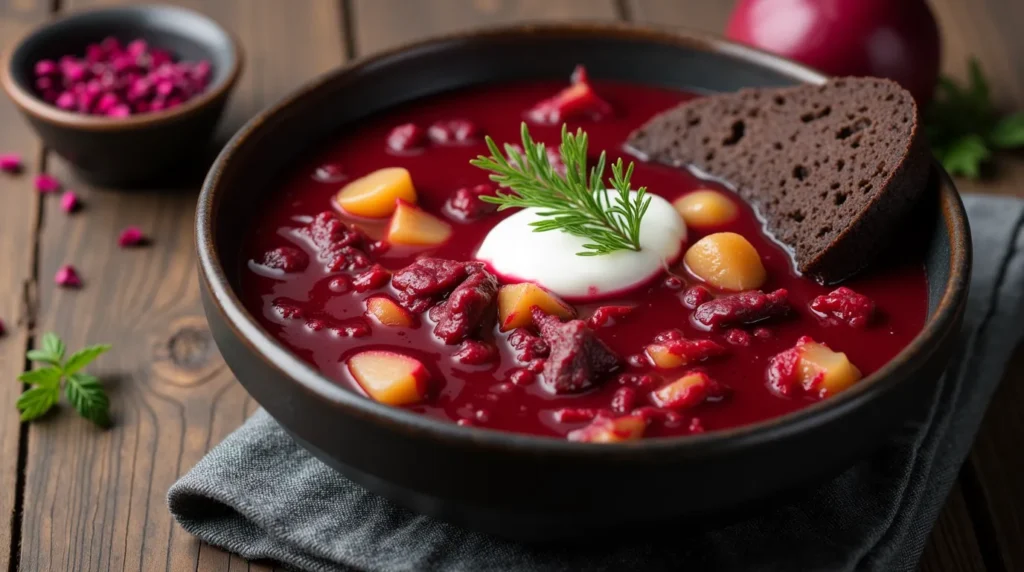
Although its origins are often contested among Eastern European nations, borscht is widely consumed throughout Russia. The base includes beets, which give the soup its vibrant red hue, alongside cabbage, potatoes, carrots, onions, and often meat such as beef. Typically served hot and garnished with a dollop of sour cream, borscht offers a hearty, comforting experience.
- Simplified Recipe:
- Sauté chopped onion and grated carrots in a pot with a little oil.
- Add cubed potatoes and diced beets, cooking until slightly tender.
- Pour in beef or vegetable stock and simmer.
- Add shredded cabbage and cook until all vegetables are tender.
- Season with salt, pepper, and a touch of dill. Serve hot with sour cream.
Pelmeni
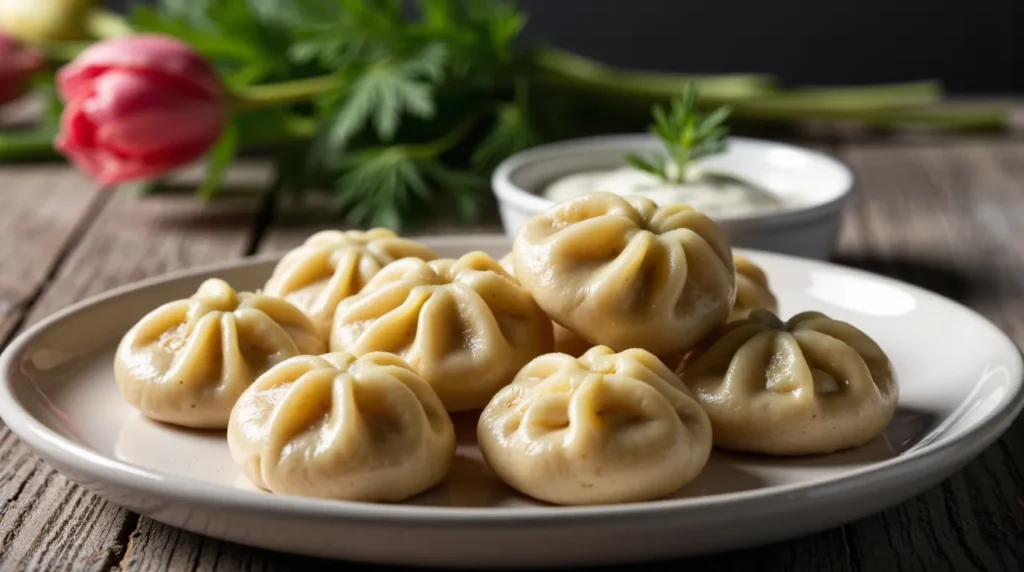
Originating from Siberia, pelmeni are small dumplings typically filled with a mix of minced beef, pork, and onion. They are boiled and served with butter, sour cream, or a splash of vinegar. Known for their comforting warmth and rich flavor, pelmeni can be frozen in large batches and cooked quickly, making them perfect for a fast, hearty meal. Regional variations may include different fillings (mushrooms or fish) and serving styles (in broth or pan-fried after boiling).
Beef Stroganoff
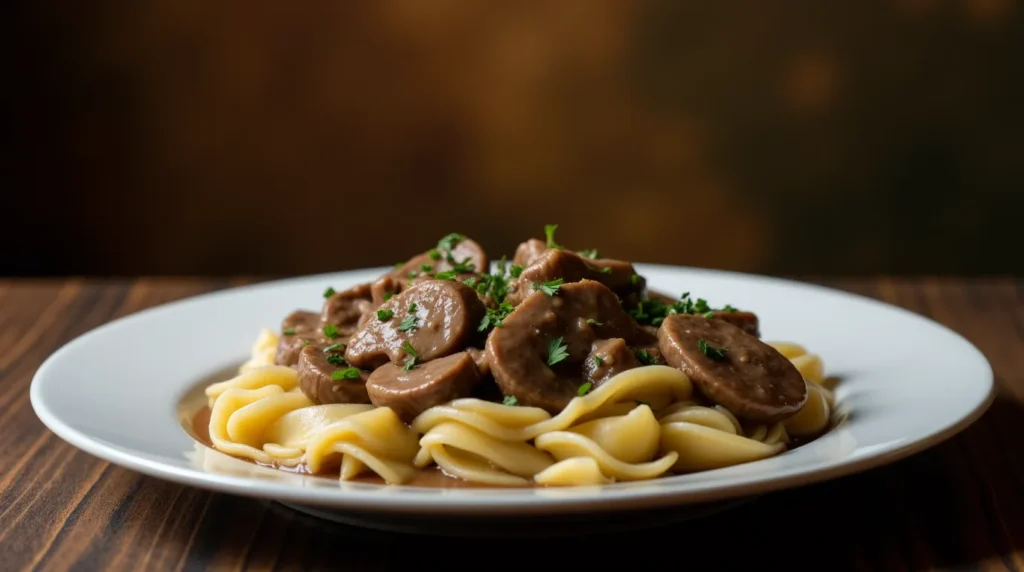
This dish, named after the aristocratic Stroganoff family, features sautéed strips of beef in a creamy sauce typically enriched with mushrooms and onions. Served over mashed potatoes or noodles, Beef Stroganoff exemplifies the fusion of traditional Russian flavors with the refined French influences introduced during the Imperial era.
Blini

Blini are thin, crepe-like pancakes made from wheat or buckwheat flour. They have deep cultural significance in Russia, served during Maslenitsa (Butter Week) to symbolize the sun and mark the end of winter. Whether topped with butter, caviar, jam, or sweet condensed milk, blini offer a versatile treat suitable for breakfast or as a dessert.
Shchi
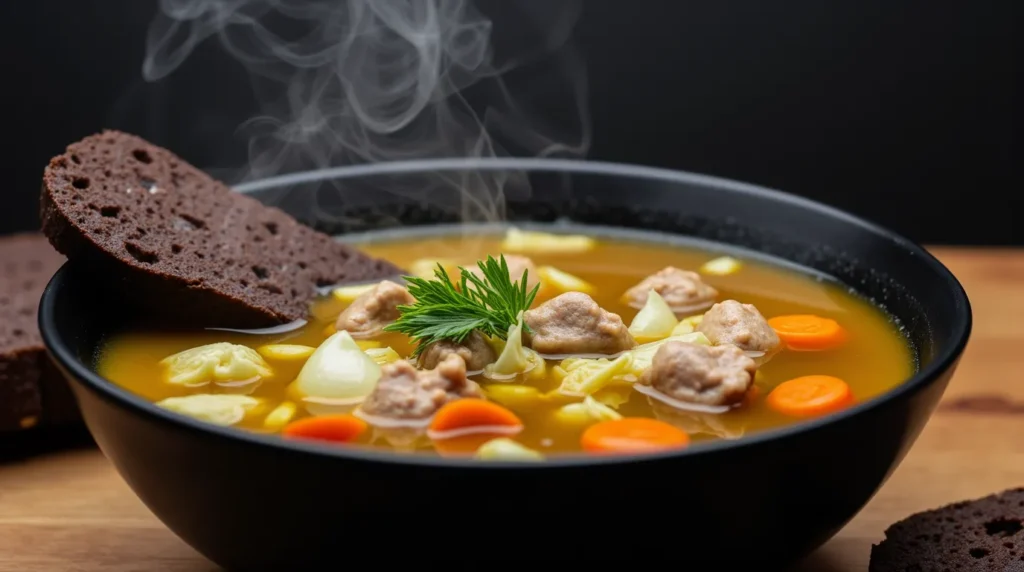
Shchi is a traditional cabbage soup made with fresh or fermented cabbage, sometimes combined with meat like pork or beef. Seasoned with herbs like dill or parsley, shchi can be served with a spoonful of sour cream, much like borscht. This humble, flavorful soup has been a Russian staple for centuries.
Solyanka
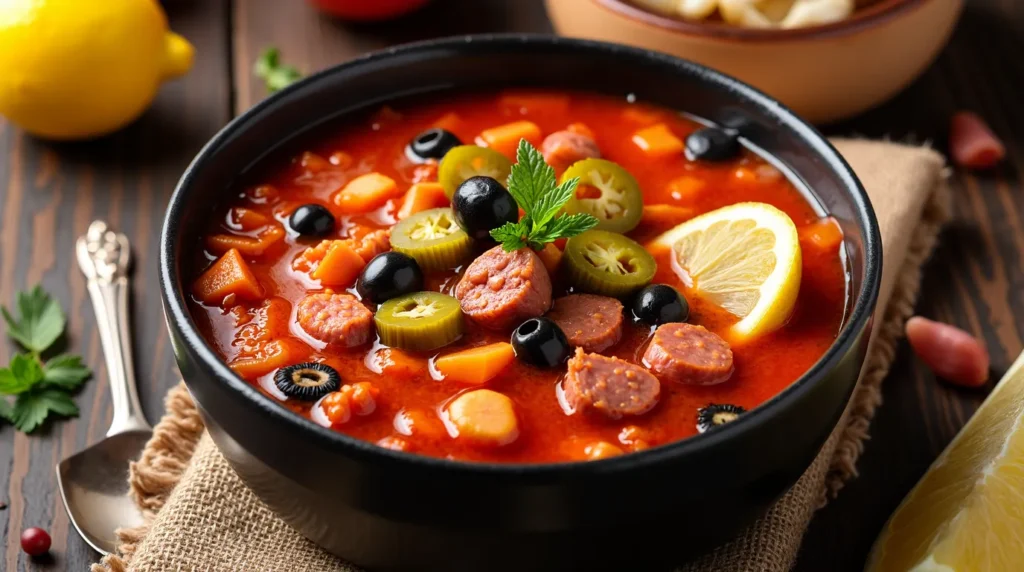
Known for its briny, sour-sweet taste, solyanka is typically made with assorted meats (sausage, ham, or bacon), pickled cucumbers, olives, and a touch of tomato paste. The soup owes its distinctive tang to pickling liquids, making it a beloved dish for those who enjoy vibrant, bold flavors.
Defining Characteristics of This Country’s Cuisine
One of the more remarkable aspects of Russian cuisine is its tendency toward hearty, comforting dishes that rely on mild seasonings rather than fiery spices. The emphasis on sour, salty, and savory elements—like pickled vegetables, sour cream, and salted fish—creates a distinctive flavor profile that stands out among global cuisines. Dishes can range from subtly sweet to pleasantly tangy, with dill, garlic, and onions providing aromatic depth.
Flavor Combinations
- Savory + Creamy: Sour cream pairs with borscht, pancakes, or dumplings.
- Salty + Tangy: Pickled cucumbers, herring, and fermented cabbage add a refreshing bite.
- Mildly Spiced: Bay leaves, peppercorns, dill, and other gentle seasonings highlight natural flavors.
Thanks to these defining characteristics, Russian cuisine appeals to those seeking a satisfying blend of home-style comfort and nuanced taste profiles. The reliance on fresh produce, pickling, and wholesome grains also makes this cuisine an exciting choice for those searching for new textures and comforting warmth.
Tips and Highlights to Encourage People to Try This Cuisine
- Cultural Immersion:
Sampling Russian cuisine offers a window into Russia’s rich history and traditions. Enjoying a bowl of borscht or a plate of pelmeni is akin to stepping into the everyday life of Russian families across generations. - Versatility:
Many dishes, especially soups and dumplings, can be easily adapted for vegetarians or those with dietary restrictions. For instance, borscht can be made without meat and enhanced with mushrooms or beans. Pelmeni can be filled with vegetables or cheese. - Health Benefits:
With its emphasis on fermented foods, soups, and whole grains, Russian cuisine can be surprisingly balanced. Pickled vegetables and dairy products like kefir provide beneficial probiotics, while hearty grains offer sustained energy. - Inexpensive and Accessible Ingredients:
Many Russian staples—potatoes, beets, cabbage, onions—are cost-effective and readily available worldwide. Exploring Russian cuisine doesn’t have to break the bank. - Tradition and Innovation:
Trying Russian cuisine can be a creative experience. You can stick to time-honored recipes passed down through generations, or experiment with modern twists inspired by contemporary chefs.
By focusing on the culture, versatility, health benefits, accessibility of ingredients, and ever-evolving creativity inherent in Russian cuisine, you can find plenty of reasons to explore this unique gastronomy.
Table Rituals and Customs
Meals in Russia often serve as communal gatherings where family and friends bond over good food and conversation. Several customs underscore the importance of hospitality and warmth in Russian culture.
Typical Meal Structure
- Breakfast (Zavtrak): Often includes kasha (porridge) or fried eggs with bread, accompanied by tea or coffee.
- Lunch (Obed): Traditionally the main meal of the day. It commonly starts with soup (borscht, shchi, or solyanka), followed by a meat or fish dish served with grains or potatoes, and rounded off with a sweet drink or dessert.
- Dinner (Uzhin): Generally lighter than lunch, consisting of salads, pasta, or leftover soup. However, in modern urban life, dinner can become the primary meal due to work schedules.
Table Etiquette
- It is considered polite for guests to bring a small gift, like flowers or dessert, if invited to a Russian home.
- Hosts typically serve their guests generous portions, and it is courteous to taste everything offered.
- Toasting is common, and a short speech or witty remark often accompanies a toast of vodka or another beverage.
- Finishing all the food on your plate is usually a sign that you enjoyed the meal, although in some contexts leaving a small amount might indicate you are full.
National Holidays and Religious Events
- Maslenitsa (Butter Week): A festive period before Lent, celebrated with plenty of blini.
- Easter: Marked by the baking of kulich (a sweet bread) and paskha (a sweet cheese dessert), highlighting Russia’s Orthodox traditions.
- New Year’s Eve: Perhaps the most celebrated holiday in modern Russia, featuring Olivier salad, pickled herring, sparkling wine, and a midnight toast.
- Victory Day (May 9): While not specifically tied to culinary traditions, large gatherings and feasts often mark this holiday.
From daily meals to festive celebrations, the Russian table is a place where traditions are preserved and shared, reflecting the nation’s deep cultural roots.
Modern Trends and Culinary Fusions
Foreign Influences
As global interconnectedness increases, Russian cuisine is experiencing new influences from Asia, Europe, and the Americas. Sushi has become extremely popular in Russia, leading to some creative crossovers like “Russian-style sushi” that might include salted fish or pickled vegetables. Restaurants offering fusion menus blend traditional Russian ingredients—like beetroot or buckwheat—with international methods, creating an exciting new chapter in Russia’s gastronomic story.
New Consumption Trends
- Vegetarianism and Veganism: A growing interest in plant-based diets is evident, especially in major cities like Moscow and St. Petersburg, where vegan versions of Russian classics (e.g., vegan borscht, mushroom pelmeni) are gaining popularity.
- Farm-to-Table: Young chefs and restaurateurs emphasize locally sourced ingredients, reviving long-forgotten regional products and artisanal farming traditions.
- Organic Food: Russia’s vast agricultural lands are conducive to organic farming. Consequently, supermarkets and specialty stores now boast organic produce that appeals to health-conscious consumers.
Young Chefs and Culinary Innovation
A new generation of chefs are reimagining classic Russian dishes through modern techniques and sophisticated presentations. Michelin-starred establishments and high-end bistros in Moscow, St. Petersburg, and beyond champion local, seasonal ingredients, while paying homage to traditional Russian cuisine. Such chefs are bridging the gap between old and new, ensuring that the heritage of Russian cooking remains relevant and appealing to contemporary diners.
Conclusion and Call to Action
Russian cuisine, steeped in centuries of history and enriched by myriad cultural influences, remains a captivating domain for any food lover. From the hearty warmth of borscht and pelmeni to the refined elegance of Beef Stroganoff and delicate blini, each dish tells a story about the land’s climate, people, and values. Whether you appreciate the mild seasonings and tangy pickles, the deep cultural traditions reflected in every aspect of mealtime, or the evolving modern trends that keep the cuisine innovative, there is no denying the unique charm and versatility of Russian cooking.
Now that you have taken a comprehensive journey through Russian cuisine—from its storied past to its modern evolution—why not try preparing a dish or two at home? Head to a local Eastern European grocery store or search online for authentic ingredients, gather friends around your table, and embrace the convivial spirit that is so integral to Russian dining. We would love to hear about your experiences, favorite Russian recipes, or any questions you might have about this remarkable culinary tradition. Feel free to share your tips, pictures, or stories in the comments section.
In a future article, we could delve deeper into Russian desserts and pastries, exploring sweet treats like medovik (honey cake) and pryaniki (spiced cookies). Stay tuned for more on the sweeter side of Russian cuisine, and happy cooking!

